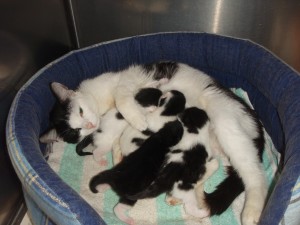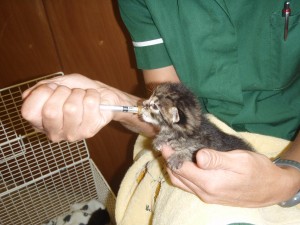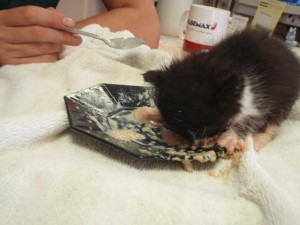Puppies and kittens dietary advice
The correct nutrition in the early stages of your pets life is vital. It starts from the first few hours when they must drink the rich colostrum from their dam and continues as they grow. Feeding the best quality pet foods will provide them with a balanced diet which will enable them to grow healthy and strong, and still have enough energy for all the running around they do!
New borns
- When puppies and kittens are new borns, by far the best food for them is their mothers milk, not only does it contain all the nutrition they need to grow, it also provides valuable antibodies to help their immune systems.
- The most important milk of all is COLOSTRUM, which is the first to be produced by the mother after birth. This contains lots of antibodies that provide valuable immunity. Always ensure that the puppy or kitten suckles as soon as possible, as after the first 12 hours of life the colostrum will no longer work.
- The best way to ensure the mother can produce enough milk for her babies is to feed her a high quality puppy or kitten food from about half way though the pregnancy until the babies are weaned. She will need a huge amount of calories and calcium to provide the milk and ordinary food cannot give her this. After all, she will have a lot of mouths to feed!
- If you want to give the puppies or kittens extra milk, or you are hand rearing them, they must have special puppy or kitten milk. They will not be able to digest cows or any other milk, and may develop a LIFE THREATENING diarrohea.

The best milk for kittens and puppies comes from their mothers but if they need to be hand reared they must be given species specific milk replacer.

Hand rearing kittens or puppies is rewarding but a lot of hard work!
Read my blog about how to hand rear kittens here!
Weaning
- Weaning can take place from about 4 weeks, use puppy or kitten biscuits softened in puppy or kitten milk, on a low plate and let the babies paddle though it. They will have a lot of fun making a lot of mess and learning to like the taste by licking themselves clean!
- Always buy a good quality puppy or kitten food, with an established reputation. The veterinary diets from companies such as Pro Plan or Hills are extremely good, and far superior from the brands more readily available in the supermarkets. They contain high levels of the vitamins and minerals required for growth, and some even contain natural antibodies to help puppy or kittens immune system as the protection from the mother wanes.
- Some breeders chose to feed extras at this stage such as scrambled eggs, weetabix in milk, minced meat, the list is endless. This is not necessary if you are providing the babies with a good quality puppy or kitten food, but if you do chose to give them extra nutrition, be sure to seek expert advice first.

Use a shallow bowl filled with puppy or kitten milk softened biscuits to help the puppies or kittens wean.
In a new home
When your new pet first arrives it is important to stick to the same feeding regime as the breeder. This helps reduce the stress your new pet will be under, and make it less likely they will develop diahorrea.
- Once you have had the puppy or kitten for about 1 week, you can gradually start changing their diet if you wish.
- Breeders often feed lots of extras such as scrambled eggs, weetabix, or even fresh mince. Extra nutrition is important during weaning, but from about 7-8 weeks old, your pet will be able to get all the nutrition they need from a good quality puppy or kitten food.
- It is not necessary to supplement your puppy or kittens diet with milk, as they should get all the calcium they need from their diet. However, they do enjoy it! Always feed specific kitten or puppy milk as cows milk can cause diahorrea.
- Puppy and kitten food is available in both wet and dry forms, many people think that young animals need a soft diet but their teeth are well able to cope with hard food, and feeding a majority dry diet is a good habit to get into as it is much better for dental care in later life, and a practical food which can be left down.
- For some pedigree breeds, there are specific diets designed for them, both as adults and young animals, click here to learn more about breed specific diets.
- Feeding the correct amount of food is also important, especially for large breeds of dog. Always follow the feeding guide on the packet, and if you have any concerns, consult your vet.
- The frequency of feeding will change as your pet gets older, the table below shows a good guide to stick to;
- From 2 to 3 months old – Feed 4 times daily
- From 3 months to 6 months – Feed 3 times daily
- From 6 months to 1 year – Feed twice daily
- From 1 year old – Once or twice daily with an adult diet.
- Please note this if you own a toy or giant breed of dog your feeding regime may be slightly different as dogs mature at different rates, always ask your vet for specific advice.
Always feed a high quality puppy or kitten food. Royal canin produce a large range of diets specifically designed for certain pedigree breeds, if you have a pedigree animal, it is worth considering feeding these
Please note this is an advice only website, if you have any specific concerns or queries about your pet, please contact your vet.